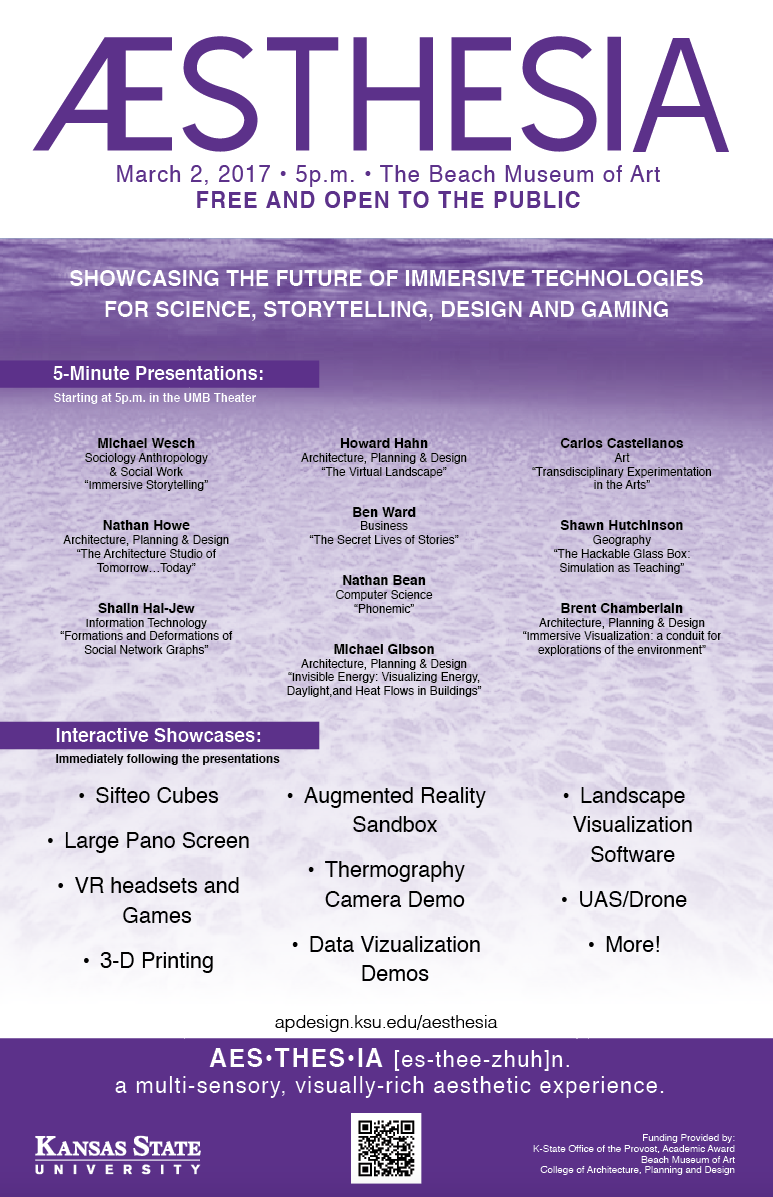AESTHESIA
Immersive environments and visualization technologies have catalyzed a revolution in storytelling, science, gaming and design. Aesthesia offers an opportunity for researchers, students and the general public to engage with K-State faculty from a variety of disciplines to explore their work, share your own and together envision the future! The event will begin with ten dynamic 5 minute presentations, followed immediately by numerous interactive showcases. Light refreshments will be provided. Please join us at the Beach Museum of Art on Thursday, March 2nd, for this unique multi-sensory experience!
For more information, contact Brent Chamberlain, Associate Professor APDesign (brentchamberlain@k-state.edu).
Click image above for posterShowcase Speakers
Michael Wesch
Sociology Anthropology & Social Work
“Immersive Storytelling”
Using virtual reality, 3D environments, and a game engine can help you craft immersive stories that inspire understanding, empathy, and compassion.
Nathan Howe
Architecture
“The Architecture Studio of Tomorrow…Today”
From environmental sensors, to 3-D printing, to virtual reality the shift in the practice of architecture design is rapidly evolving and grant a depth of analysis in world of design previously unfathomable. This presentation will focus on concepts of emerging architectural design practices.
Shalin Hai-Jew
Information Technology
"Formations and Deformations of Social Network Graphs"
Social network graphs are node-link (entity-relationship) diagrams that show relationships between people and groups. Open-source tools like NodeXL Basic (available on Microsoft’s CodePlex) enable the capture of network data from select social media platforms through third-party add-ons and social media APIs.
Howard Hahn
Landscape Architecture and Regional & Community Planning
"The Virtual Landscape"
Discover how landform and plants can be acquired, manipulated, and represented in a virtual environment under various view conditions for public review, storytelling, and scientific applications.
Ben Ward
Business
“The Secret Lives of Stories”
Join Ben Ward as we slide down the rabbit hole on a journey along the many paths of multilinear storytelling and transmedia experiences. Along the way, we will see how deep the rabbit hole goes and explore many of the facets of telling tales and drawing our audiences into shared experiences that carry meaning and memories well beyond the narrative.
Nathan Bean
Computer Science
“The Hackable Glass Box: Simulation as Teaching”
Simulations represent powerful learning tools, allowing us to develop an intuitive sense of complex systems via iterative interaction. Through interactive simulations, complex mathematical and statistical models can be recast from the abstract into the concrete.
Michael Gibson
Architecture
“Invisible Energy: Visualizing Energy, Daylight, and Heat Flows in Buildings”
We often understand buildings just for their appearance, but buildings are responsible for a significant amount of energy consumption that users never see. New tools and technologies allow architects and users to better relate, through visualization, building design and energy consumption.
Carlos Castellanos
Art
“Transdisciplinary Experimentation in the Arts”
An overview of science and technology-based artworks, with a focus on ecological and biological arts. These works defy categorization and engage directly with the technosciences, often with strong elements of public engagement
Shawn Hutchinson
Geography
“Visual-Tactile Learning with High-Tech Sandboxes”
Visualization helps people process multidimensional data rapidly and in context to generate knowledge and gain insight about relationships, processes, patterns, and trends. The augmented reality sandbox supports this by activating two key senses – sight and touch – to help students better understand digital representations of topography, the physical differences in landform types (geomorphology), and the influence those broad landforms and local relief have on the movement of water through a landscape. This “multisensory” experience can reinforce learning in the science classroom, especially among students with less connectedness to nature.
Brent Chamberlain
APDesign
“Immersive Visualization: a conduit for exploring perceptions of the environment”
Explore 3D virtual worlds that are being used to better understand how we interact with and are impacted by the environment around us. Learn how we are working to understand how the environment plays a role in helping us develop a sense of place, reduce stress and design more aesthetic landscapes.

